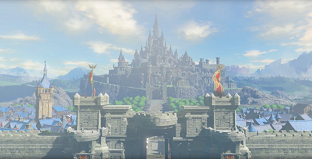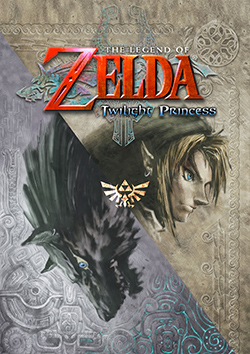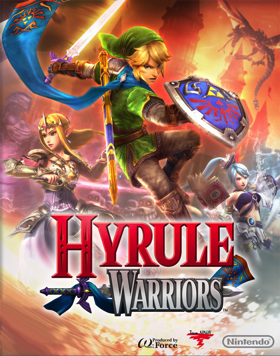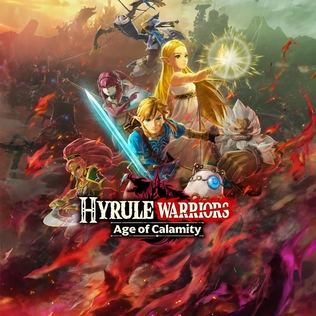
The Legend of Zelda is a media franchise created by the Japanese game designers Shigeru Miyamoto and Takashi Tezuka. It is primarily developed and published by Nintendo; some portable installments and re-releases have been outsourced to Flagship, Vanpool, Grezzo, and Tantalus Media.

The Legend of Zelda is a video game franchise created by video game designers Shigeru Miyamoto and Takashi Tezuka and mainly developed and published by Nintendo. The universe of the Legend of Zelda series consists of various lands, the most predominant being Hyrule. The franchise is set within a fantasy world reminiscent of medieval Europe which consists of several recurring locations, races and creatures. The most prominent race in the series are the Hylians, a humanoid race with elfin features identifiable by their long, pointed ears. The series' lore contains a creation myth, several fictional alphabets, the most prominent being Hylian, and a fictional universal currency, the rupee. Most games in The Legend of Zelda series follow a similar storyline, which involves the protagonist Link battling monsters to save Princess Zelda and defeat a villain, which is often the series' main antagonist, Ganon. Nintendo developed the series' lore into a timeline that spans thousands of years across its history.

The Legend of Zelda: Majora's Mask is a 2000 action-adventure game developed and published by Nintendo for the Nintendo 64. It was the second The Legend of Zelda game to use 3D graphics, following Ocarina of Time (1998). Designed by a creative team led by Eiji Aonuma, Yoshiaki Koizumi, and Shigeru Miyamoto, Majora's Mask was completed in less than two years. It features enhanced graphics and several gameplay changes, but reuses elements and character models from Ocarina of Time, which the game's creators called a creative decision made necessary by time constraints.

The Legend of Zelda: The Wind Waker is an action-adventure game developed and published by Nintendo for the GameCube. An installment in The Legend of Zelda series, it was released in Japan on December 13, 2002, in North America on March 24, 2003, and in Europe on May 2, 2003.

Dynasty Warriors is a series of Japanese hack and slash action video games created by Omega Force and Koei. The series is a spin-off of Koei's turn-based strategy Romance of the Three Kingdoms series, based upon the Chinese novel of the same name, which is a romanticised retelling of the Chinese Three Kingdoms period.

Princess Zelda is a character in Nintendo's The Legend of Zelda video game series. She was created by Shigeru Miyamoto for the original 1986 game The Legend of Zelda. As one of the central characters in the series, she has appeared in the majority of the games in various incarnations. Zelda is the elf-like Hylian princess of the kingdom of Hyrule, an associate of the series protagonist Link, and bearer of the Triforce of Wisdom.

Link is a fictional character and the protagonist of Nintendo's video game franchise The Legend of Zelda. He was created by Japanese video game designer Shigeru Miyamoto. Link was introduced as the hero of the original The Legend of Zelda video game in 1986 and has appeared in a total of 21 entries in the series, as well as a number of spin-offs. Common elements in the series include Link travelling through Hyrule whilst exploring dungeons, battling creatures, and solving puzzles until he eventually defeats the series' primary antagonist, Ganon, and saves Princess Zelda.

Ganon is a character and the main antagonist of Nintendo's The Legend of Zelda video game series and franchise, as well as the final boss in many Zelda titles. In his humanoid Gerudo form, he is known as Ganondorf. A massive and malevolent porcine creature, Ganon first appeared in the original The Legend of Zelda game in 1986, while his alter ego, Ganondorf, was introduced in Ocarina of Time. He has since appeared in the majority of the games in the series in various forms. He is the archenemy of the protagonist Link and Princess Zelda of Hyrule and originally the leader of the Gerudo, a race of humanoid desert nomads before becoming the ruler of his demon army.

The Legend of Zelda: Twilight Princess is a 2006 action-adventure game developed and published by Nintendo for the GameCube and Wii. Originally planned for release exclusively on the GameCube in November 2005, Twilight Princess was delayed by Nintendo to allow its developers to refine the game, add more content, and port it to the Wii. The Wii version was a launch game in North America in November 2006, and in Japan, Europe, and Australia the following month. The GameCube version was released in December 2006 as the final first-party game for the console.

Tingle is a recurring character in The Legend of Zelda series, designed by Takaya Imamura. He first appeared in Majora's Mask, where he is a map salesman who wants to become a fairy. He has since appeared in several installments, including The Wind Waker, where he provides maps to help Link find pieces of the Triforce. He has gone on to be the star of Freshly-Picked Tingle's Rosy Rupeeland, where his origin as Tingle is shown as him tasked with collecting as many Rupees as possible. He also appears in its sequel Irozuki Tingle no Koi no Balloon Trip, where he is transported into a storybook and has to enter into relationships with women in order to escape.

Midna is a fictional character in Nintendo's The Legend of Zelda series, introduced as one of the main protagonists in Twilight Princess. She is a member of the magic-wielding Twili who joins forces with Link to prevent the kingdom of Hyrule from being enveloped by a corrupted parallel dimension known as the Twilight Realm. While Midna appears as an imp-like creature in the majority of Twilight Princess, her actual form is humanoid. She was designed by Yusuke Nakano and voiced by Akiko Kōmoto. Midna also appears as a playable character in Hyrule Warriors, and makes minor appearances in the Super Smash Bros. series.

The Legend of Zelda: Breath of the Wild is a 2017 action-adventure game developed and published by Nintendo for the Nintendo Switch and Wii U. Set at the end of the Zelda timeline, the player controls an amnesiac Link as he sets out to save Princess Zelda and prevent Calamity Ganon from destroying the world. Players explore the open world of Hyrule while they collect items and complete objectives such as puzzles or side quests. Breath of the Wild's world is unstructured and encourages exploration and experimentation; the story can be completed in a nonlinear fashion.

The Legend of Zelda: A Link Between Worlds is a 2013 action-adventure game developed and published by Nintendo for the Nintendo 3DS. The game is the 17th in The Legend of Zelda series and is a sequel to the 1991 title The Legend of Zelda: A Link to the Past. Announced in April 2013, A Link Between Worlds was released in Australia, Europe, and North America in November, and in Japan a month later.

Hyrule Warriors is a 2014 hack and slash game developed by Omega Force and Team Ninja and published by Nintendo for the Wii U. The game is a collaboration between Koei Tecmo and Nintendo, mixing settings and characters from Nintendo's The Legend of Zelda with the gameplay of Koei's Dynasty Warriors series. Hyrule Warriors was released in Japan in August 2014, and worldwide the following month. It became one of the best-selling games on the Wii U. An updated port, Hyrule Warriors Legends, was released for the Nintendo 3DS in Japan in January 2016 and worldwide in March of the same year. A second enhanced port, Hyrule Warriors: Definitive Edition, was released for the Nintendo Switch in 2018. A successor, Hyrule Warriors: Age of Calamity, was released exclusively for the Nintendo Switch in November 2020.

Fire Emblem Warriors is a hack and slash action role-playing game developed by Omega Force and Team Ninja, and published by Koei Tecmo in Japan and Nintendo internationally for the Nintendo Switch and New Nintendo 3DS. The game was released in Japan in September 2017, and worldwide the following month. The game is a collaboration between Koei Tecmo's Dynasty Warriors franchise and Nintendo and Intelligent Systems's Fire Emblem series.

Omega Force is a Japanese video game developer and a division of Koei Tecmo, founded in 1996 by Akihiro Suzuki and Kenichi Ogasawara, and is best known for the Dynasty Warriors video games.

Hyrule Warriors: Age of Calamity, released in Japan as Zelda Musō: Yakusai no Mokushiroku, is a 2020 hack and slash game developed by Omega Force and published by Koei Tecmo in Japan and by Nintendo internationally for the Nintendo Switch. Like the original Hyrule Warriors (2014), Age of Calamity is a crossover that mixes the world and characters of Nintendo's The Legend of Zelda series with the gameplay of Koei Tecmo's Dynasty Warriors series, and acts as a spin-off prequel to The Legend of Zelda: Breath of the Wild (2017).

Rule 63 is an Internet meme that states that, as a rule, "for every character there is a gender swapped version of that character". It is one of the "Rules of the Internet" that began in 2006 as a Netiquette guide on 4chan and were eventually expanded upon by including deliberately mocking rules, of which Rule 69 is an example. It began to see general use in fandom communities as a term to refer to both fan-made and official gender flips of existing fictional characters.

Sidon is a fictional character in Nintendo's The Legend of Zelda series. He first appeared as a major character in The Legend of Zelda: Breath of the Wild. He reappears as a playable character in the hack-and-slash video game Hyrule Warriors: Age of Calamity and as a non-playable character in The Legend of Zelda: Tears of the Kingdom. Sidon is the prince and eventual king of the amphibious Zora and younger brother of Mipha, one of the four Champions who helped Princess Zelda and Link fight Calamity Ganon. In Breath of the Wild, Sidon helps Link to reach Divine Beast Vah Ruta so he can defeat Waterblight Ganon and free it from Ganon's control. Since his debut, Sidon has received an overwhelmingly positive reception from both fans and critics. He was designed by Yuko Miyakawa, who gave him grey skin and a hammerhead shark motif, though his skin was changed both due to blending issues and to match his skin color with Mipha's. Due to his personality, he has achieved a large fan following and has also been the subject of fan art and Internet memes on social media.



















